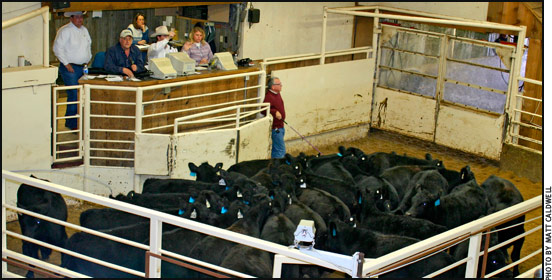
In the Cattle Markets
A look back, and a look forward.
This year, fed-cattle prices will average about 18% above a year ago, while calf prices surge about 30%. The only real beneficiaries of record-high cattle prices in 2011 will be cow-calf producers and breeding stock providers in non-drought regions.
After a few good months in early 2011, cattle feeding began to record huge losses. Even with higher fed-cattle prices this fall, the red ink will continue on feedlot closeouts for at least the balance of 2011.
Cattle feeders pocketed good profits during the first four months of the year, but as the second quarter progressed seasonally lower, fed-cattle prices collided with surging feedstuff costs. Cost-of-gain in feedlots shot up to well over $100.00 per hundredweight (cwt.). Corn costs set record highs and caused rather volatile calf and yearling prices.
Several forces are shaping the U.S. cattle and beef industry, all of which may have rather long-term implications. First, drought is shrinking the U.S. beef cow herd, which had already shrunk during recent years. Second, high feedstuff costs are very problematic, a situation that is likely to persist. Overall, three factors will continue to support cattle prices:
- 1. cyclically shrinking cattle supplies;
- 2. strong export markets (beef and byproducts); and
- 3. rather tight domestic supplies of competing meats and poultry.
There are lots of questions about 2012; most importantly, will the U.S. slip into another economic recession? How high will oil and corn prices be? Preliminary forecasts for 2012 assume modest economic growth in the U.S. and corn prices slightly lower than 2011's record high.
Preliminary forecasts for 2012 put the slaughter steer price 5%-8% above 2011's. The strongest prices of the year are forecast to be in the second and fourth quarters, similar to the seasonal pattern of 2011. For the first time ever, quarterly average fed-cattle prices over $120.00 are possible.
The dominant factor influencing calf and yearling markets in 2012 will be grain prices. Crop-year ending corn stocks will only amount to a few weeks of usage in 2012. Grain prices are expected to remain volatile, causing potentially large price swings in calf and yearling prices. Opportunities to make money by putting pasture-based weight gains on calves should continue, given ongoing high cost-of-gain in feedlots. Of course, volatile prices mean sound business and risk management plans need to be developed before purchasing calves.
In the Southern Plains, forecasts call for yearling and calf prices in 2012 to post a small annual increase. It will be difficult to match the yearling and calf prices posted in the first quarter of 2011 given costs faced by cattle feeders. Over the calendar year, the weakest yearling prices could be in the first quarter of 2012, again assuming a normal growing season next summer. Still, a very strong fed-cattle market should keep yearling prices above 2011's for the second half of the year. For the year, 700- to 800-pound (lb.) steers in the Southern Plains are forecast to average in the $129.00 to $137.00 per cwt. range, which would be slightly above 2011 prices.
 Calf prices could post modest year-on-year declines during much of the first half of 2012. But in the second half of the year, prices could post annual gains. In fact, calf prices in the fall quarter of the year could eclipse 2011's by several dollars per cwt.
Calf prices could post modest year-on-year declines during much of the first half of 2012. But in the second half of the year, prices could post annual gains. In fact, calf prices in the fall quarter of the year could eclipse 2011's by several dollars per cwt.








